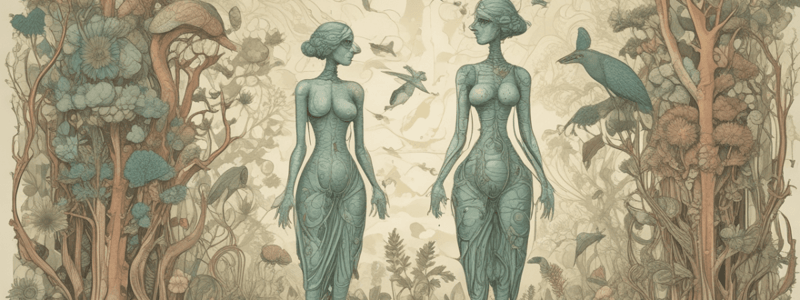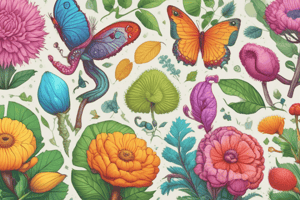Podcast
Questions and Answers
What determines the growth patterns of an individual, resulting in either no further growth or continued growth after reaching sexual maturity?
What determines the growth patterns of an individual, resulting in either no further growth or continued growth after reaching sexual maturity?
- Genetic predisposition
- Predator chemical cues
- Resource availability
- Type of growth, either determinate or indeterminate (correct)
What is the term for the gradual decrease in fitness with age?
What is the term for the gradual decrease in fitness with age?
- Senescence (correct)
- Fecundity
- Parity
- Longevity
Which of the following is an example of phenotypic plasticity?
Which of the following is an example of phenotypic plasticity?
- Two Daphnia clones with different genotypes
- Two Daphnia clones with different fecundity rates
- Two Daphnia clones with different predation risks
- Two Daphnia clones with the same genotype but different environmental conditions (correct)
What is the term for the number of offspring per capita in a given time interval?
What is the term for the number of offspring per capita in a given time interval?
What type of growth pattern is characteristic of many species of plants, invertebrates, fishes, reptiles, and amphibians?
What type of growth pattern is characteristic of many species of plants, invertebrates, fishes, reptiles, and amphibians?
What is the primary factor influencing the survival rate of an individual?
What is the primary factor influencing the survival rate of an individual?
What is the term for the number of reproductive episodes in an individual's lifetime?
What is the term for the number of reproductive episodes in an individual's lifetime?
What is the term for the life span of an organism?
What is the term for the life span of an organism?
What is the term for organisms that have a single reproductive cycle before death?
What is the term for organisms that have a single reproductive cycle before death?
What is the distribution of survival rates in a population?
What is the distribution of survival rates in a population?
In which organisms do multiple reproductive cycles occur?
In which organisms do multiple reproductive cycles occur?
What is the primary reason for trade-offs in resource allocation?
What is the primary reason for trade-offs in resource allocation?
What is the main difference between semelparous and iteroparous organisms?
What is the main difference between semelparous and iteroparous organisms?
What is the outcome of adding one egg to the European magpie's brood?
What is the outcome of adding one egg to the European magpie's brood?
What is associated with a short lifespan in birds?
What is associated with a short lifespan in birds?
What is the main characteristic of stress tolerators in plants?
What is the main characteristic of stress tolerators in plants?
What is the primary difference between fast and slow life histories?
What is the primary difference between fast and slow life histories?
What is the main factor affecting the life history of plants, according to J. Philip Grime?
What is the main factor affecting the life history of plants, according to J. Philip Grime?
What is the main characteristic of ruderal plants?
What is the main characteristic of ruderal plants?
What is the result of removing eggs from a European magpie's brood?
What is the result of removing eggs from a European magpie's brood?
What is the primary factor influencing the expression of life-history traits?
What is the primary factor influencing the expression of life-history traits?
What is the result of phenotypic plasticity in response to predator chemical cues?
What is the result of phenotypic plasticity in response to predator chemical cues?
What determines the timing of metamorphosis in organisms?
What determines the timing of metamorphosis in organisms?
What is the characteristic of indeterminate growth in organisms?
What is the characteristic of indeterminate growth in organisms?
What is the relationship between survival rate and longevity?
What is the relationship between survival rate and longevity?
What is the primary factor influencing the reproductive strategy of an organism?
What is the primary factor influencing the reproductive strategy of an organism?
What is the characteristic of semelparous organisms?
What is the characteristic of semelparous organisms?
What is the result of phenotypic plasticity in response to environmental conditions?
What is the result of phenotypic plasticity in response to environmental conditions?
What is the primary factor influencing the life-history traits of an organism?
What is the primary factor influencing the life-history traits of an organism?
What is the characteristic of determinate growth in organisms?
What is the characteristic of determinate growth in organisms?
What is the primary reason why organisms cannot live longer, reproduce often, and grow faster?
What is the primary reason why organisms cannot live longer, reproduce often, and grow faster?
What is the trade-off between offspring number and parental care?
What is the trade-off between offspring number and parental care?
What is the main characteristic of a slow life history?
What is the main characteristic of a slow life history?
What is the result of investing more time in feeding offspring?
What is the result of investing more time in feeding offspring?
What is the main difference between fast and slow life histories?
What is the main difference between fast and slow life histories?
What is the primary factor affecting the life history of plants, according to J. Philip Grime?
What is the primary factor affecting the life history of plants, according to J. Philip Grime?
What is the main characteristic of ruderal plants?
What is the main characteristic of ruderal plants?
What is the trade-off between longevity and reproductive onset?
What is the trade-off between longevity and reproductive onset?
What is the result of adding one egg to the European magpie's brood, in terms of success rate?
What is the result of adding one egg to the European magpie's brood, in terms of success rate?
Why do organisms have multiple reproductive cycles?
Why do organisms have multiple reproductive cycles?
Study Notes
Life History Traits
- Life history traits include growth and development, survival, and reproduction, which can be influenced by environmental conditions and have both heritable and phenotypically plastic components.
Growth and Development
- Phenotypic plasticity: same genotype, different phenotypes in response to environmental cues (e.g., Daphnia clones responding to predator chemical cues)
- Resource availability affects growth and development (e.g., lower body mass in frogs with limited food)
Survival
- Survival rate: proportion of individuals alive at a given time
- Longevity: life span of an organism
- Senescence: gradual decrease in fitness with age
Reproduction
- Fecundity: number of offspring per capita in a given time interval
- Parity: number of reproductive episodes
- Semelparous organisms: single reproductive cycle before death
- Iteroparous organisms: multiple reproductive cycles
- Seasonal breeding: mating occurs during a specific time of year
- Age of first breeding and menopause: significant reproductive milestones
Trade-Offs
- Principle of allocation: energy and nutrients cannot be used for multiple purposes simultaneously
- Examples of trade-offs:
- Offspring size vs number
- Number of offspring vs parental care
- Parental care vs parent survival
- Longevity vs reproductive onset
Examples of Trade-Offs
- Offspring size vs number: big seeds in goldenrod plants contain more energy, but fewer seeds are produced
- Offspring number vs parental care: more offspring means less per capita care, leading to lower survival rates (e.g., European magpies)
- Parental care vs parental survival: investing more time in parental care increases mortality for parents
- Longevity vs reproductive onset: early start in reproduction is associated with shorter lifespan (e.g., birds vs fish)
Groupings from Life History
- Fast vs slow species
- Functional groups in plants (stress tolerators, competitors, and ruderals) based on stress, competition, and frequency of disturbances (Grime's proposal)
Life History Speed Continuum
- Slow life history: late sexual maturity, long life span, low fecundity, high parental investment
- Fast life history: early sexual maturity, short life span, high fecundity, little parental investment
Life History Traits
- Life history traits include growth and development, survival, and reproduction, which can be influenced by environmental conditions and have both heritable and phenotypically plastic components.
Growth and Development
- Phenotypic plasticity: same genotype, different phenotypes in response to environmental cues (e.g., Daphnia clones responding to predator chemical cues)
- Resource availability affects growth and development (e.g., lower body mass in frogs with limited food)
Survival
- Survival rate: proportion of individuals alive at a given time
- Longevity: life span of an organism
- Senescence: gradual decrease in fitness with age
Reproduction
- Fecundity: number of offspring per capita in a given time interval
- Parity: number of reproductive episodes
- Semelparous organisms: single reproductive cycle before death
- Iteroparous organisms: multiple reproductive cycles
- Seasonal breeding: mating occurs during a specific time of year
- Age of first breeding and menopause: significant reproductive milestones
Trade-Offs
- Principle of allocation: energy and nutrients cannot be used for multiple purposes simultaneously
- Examples of trade-offs:
- Offspring size vs number
- Number of offspring vs parental care
- Parental care vs parent survival
- Longevity vs reproductive onset
Examples of Trade-Offs
- Offspring size vs number: big seeds in goldenrod plants contain more energy, but fewer seeds are produced
- Offspring number vs parental care: more offspring means less per capita care, leading to lower survival rates (e.g., European magpies)
- Parental care vs parental survival: investing more time in parental care increases mortality for parents
- Longevity vs reproductive onset: early start in reproduction is associated with shorter lifespan (e.g., birds vs fish)
Groupings from Life History
- Fast vs slow species
- Functional groups in plants (stress tolerators, competitors, and ruderals) based on stress, competition, and frequency of disturbances (Grime's proposal)
Life History Speed Continuum
- Slow life history: late sexual maturity, long life span, low fecundity, high parental investment
- Fast life history: early sexual maturity, short life span, high fecundity, little parental investment
Studying That Suits You
Use AI to generate personalized quizzes and flashcards to suit your learning preferences.
Description
Learn about life history traits, including growth, development, survival, and reproduction, and how they are influenced by environmental conditions, genetics, and phenotypic plasticity. Understand how traits can be affected by conspecific and interspecific effects.




